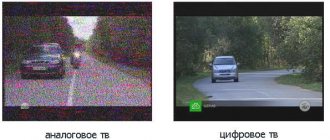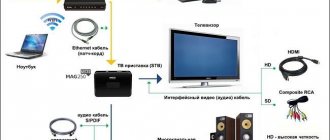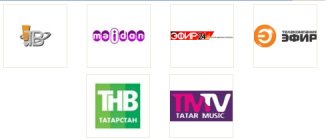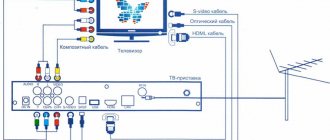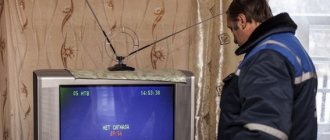Watching TV is one of the favorite and traditional ways to spend your free time. Therefore, the information that the analog signal will eventually disappear and be replaced by digital television causes significant emotions.
Russia is one of the countries that, with some delay, is changing the format of broadcast television from analogue to digital. Soon we will all be able to watch TV in better quality. However, before this happens, it is worth knowing the answers to numerous questions related to the transition to a new broadcast standard. For example, such as: why is this “connection to T2”? What is digital TV anyway? Why this T2 tuner? When to start this “connection”? And there are many more different “hows” and “whys”. But it's better in order.
What is digital terrestrial television
Digital terrestrial television is a method of transmitting a TV stream in the form of a digital signal to receivers, for example, televisions and digital TV decoders.
The operating principle of digital television is a special compression of image and sound (in the MPEG-4 system). Thanks to this compression, it is possible to send 4–16 times more television programs than with analog TV. In addition, digital transmission, being a very advanced method, has made it possible to easily add a number of additional useful services.
Advantages of the new format television:
- it is free, just like the free, familiar analogue terrestrial signal;
- it doesn’t matter how many channels you watched on your antenna, two, or five, or ten, but you will watch 20 Russian channels;
- you won’t care whether the analog signal has already been turned off or not;
- The image on the TV will be of high quality, without noise. There will not be the slightest interference on any channel.
Not bad, right?
How to switch your TV to digital TV from cable
A TV that has cable TV is already connected to digital TV. The user will be able to view 20 main channels, as well as additional ones, which are broadcast according to the tariff.
The user may want to give up pay TV, so you should be sure that it is possible to connect to terrestrial television. If the distance and quality of the signal allows, then in this case you need to stop paying the fee and connect all the necessary equipment (you will need an antenna and cables).
Digital television in Russia
Russia is one of the last countries on the Eurasian continent to begin introducing new broadcasting standards. But such a delay predetermined a massive transition to the more convenient and progressive DVB-T2 standard, which, unlike the previously widespread DVB-T, allows for 30% more productive use of television networks. The answer to the question “when will our state finally switch to digital television?” is a federal target program for the development of digital broadcasting in the Russian Federation.
Perhaps you have long been interested in the issue of transition to digital television in Russia and you are also wondering: will additional transmitters be installed or will the power of existing transmitters be increased? And when can we expect this? Let's be optimistic, but let's wait...5 years.
In addition to the usual increase in transmitter power, it is also necessary to create synchronous broadcast networks. When several not very powerful transmitters operate on the same frequency, and each one covers its own small area with the broadcast signal without interfering with each other. By and large, it is necessary to take into account not only the number of transmitters, but also the power of each individual transmitter.
In addition to good coverage, another important problem must be solved: the provision of collective terrestrial antennas in multi-storey buildings.
So, if you receive a television signal with an over-the-air antenna, that is, you are watching “not satellite” and “not cable” and you have no more than 19 channels. You can try to switch to digital television now, or today, or in the coming days.
Connecting two or more TVs to one set-top box
The ideal option is to connect one TV to one set-top box. Therefore, the optimal solution would be to purchase separate receivers for TV devices. Naturally, this will not be the most budget-friendly way to solve the problem. The user connects the cable to the splitter, and then from each input it goes to separate receivers. The connection diagram is as simple and clear as possible.
If you wish, you can connect a second TV to one set-top box; to do this, you just need to use all available interfaces. For example, we connect the first device via HDMI, and the second using “tulips”.
Connecting digital TV using this principle is not the best option, since both TVs will receive an identical signal. In other words, the picture is synchronized, you cannot watch different TV channels at the same time.
An additional solution to the problem is to purchase an RF modulator that will supply separate decoded signals to TVs. However, the cost of such a device is significantly higher than the price of a conventional receiver.
Digital television formats
DVB is an acronym for the Digital Video Broadcasting Project, founded in 1993. Currently, this large-scale open project brings together about 300 organizations from 35 countries. The basis for the work of the DVB consortium was a shift towards technical requirements in the development priorities of systems for the delivery of digital information. The end result of the DVB project was a family of new communication standards established for video broadcasting:
- satellite – DVB-S and DVB-S2,
- cable – DVB-C,
- terrestrial DVB-T and DVB-T2.
Terrestrial digital television is gradually replacing analogue broadcasting. This process has already been implemented in many European countries, where the digitization of terrestrial TV has already been completed and analogue broadcasting has been switched off.
What are digital TV multiplexes?
Multiplex DVB-T2 or digital multiplex (from English multiplex) is a package of television channels, radio stations and additional services. Simultaneously broadcast to the recipient in digital (multiplexed) form, on one frequency channel. In other words, it is a combined coded data stream consisting of at least two data streams or more. The multiplex may include information about radio, television, conditional access and additional services programs broadcast on a specific TV channel.
On the territory of the Russian Federation, 20 digital TV channels are currently available for free reception, combined into two multiplexes RTRS-1 and RTRS-2.
Why is the Russian Federation switching to DTV?
The beginning of this large-scale process was documented back in 2009. In practice, the main stages of implementation occurred in 2018-2019.
The main prerequisites for such changes are the following:
- social involvement of residents of distant regions;
- abandoning analogue television saves budget funds;
- digital television is simpler and more convenient to maintain.
The transition is carried out according to the federal program, and therefore analogue broadcasting is gradually switched off in each region. If the population does not prepare the equipment to receive a digital signal, after the planned shutdown date the TV simply will not show anything.
General setup instructions
You may be interested in: Setting up a digital antenna
The key to success in TV reception is not only what kind of antenna you use, but also where the antenna is located and in which direction it is pointed. The antenna receives only the television signal that is present at the point where it is located.
To watch free terrestrial digital television DVB-T2, you will have to reconfigure your TV and select the “digital” format in the menu, not analog. Then you need to enable auto-tuning through the TV menu, and then see if your TV has found 20 open over-the-air digital television channels. As a rule, in the TV menu before auto-tuning, you can choose: search only for analogue channels, or digital, or all together.
How to locate a TV tower
The first thing you will have to find out is whether you live in an area with at least some reception of a digitized signal? You can find the location of the nearest T2 tower by finding your region and locality on the digital TV network coverage map. Are you in an area of at least some weak coverage?
You may be interested in: CETV coverage map
Having traced the detailed address of the tower, you can use a satellite map and draw a clear straight line from the transmitter to your home, taking into account all obstacles. By zooming in on the map near your home, you will see exactly where your antenna should be pointed.
Are there places where the digitized signal cannot reach? Yes, there are places where the signal is very weak, and it is still almost impossible to receive it. An inconspicuous technical feature: if the existing Russian digital television broadcasting network is supplemented with synchronous transmitters, the broadcast quality will significantly improve, and the digital coverage area will quickly expand. But you and I do not influence this process.
Methods for receiving a digital signal
Digitization of television signals, although it came to Russia late, has come forever. We will all receive digital television through an antenna; another, such a widespread method for receiving terrestrial terrestrial TV has not yet been invented.
Television of the new standard is not cable or satellite or IPTV television; it is broadcast over the air in the new DVB-T2 standard (abbreviated as T2). For T2 television:
- no need for a satellite dish
- no broadband internet connection required,
- There is no need for the house to have equipment from a local company that distributes cable television.
- no payment required.
Television in the DVB-T2 standard is free.
Unfortunately, digitization will also bring with it a harvest for scammers who will claim that in order to receive the new television, a mandatory replacement of the antenna on the roof is necessary, offering their services - of course, for an additional fee.
In fact, in most cases there is no need to replace the antenna. If you have already received analog TV in good quality through your antenna, then you can receive digital TV without any problems. Replacing the antenna to receive it may only be necessary in “difficult terrain.” In this case, to improve reception, you may have to exchange the broadband antenna for a directional antenna with an amplifier.
Required equipment for viewing
As you already know, T2 reception goes to a regular home antenna, and it’s good when this antenna is external and not indoor. But now it is no longer the TV that receives and processes the antenna signal, now this is done by the decoder (other common names for this set-top box are receiver, tuner), which understands the DVB-T2 standard. Decrypted by the receiver, the video signal is sent through the video input to the TV.
Any TV is suitable for watching T2, from an old black-and-white tube TV to a modern LCD TV, and it doesn’t matter in which country it is made.
But does your TV have the necessary video input? If not, then you need to purchase a tuner that has an RF modulator, another name for an RF-OUT modulator, or an RF modulator. The signal from such a tuner must be fed to the antenna input of the TV, retuning the TV to the modulator frequency.
Perhaps your good, modern TV can independently receive a digital signal, then you will watch digital television without a set-top box in T2 format. If this is the case, then DVB-T2 will definitely be written in the instructions for your TV.
You may be interested in: Choosing an over-the-air digital set-top box
The best modern DVB-T2 TV set-top boxes
You can find a huge number of digital set-top boxes on the modern market, but we have highlighted the five devices that have the best characteristics. Experts choose them for viewing DVB-T2.
Oriel 963 DVB T2
The receiver is used to operate two dozen digital channels. This model is considered the best option for those users who are accustomed to comfort and at the same time do not want to delve into the device settings for a long time. It is worth noting that this receiver belongs to standard digital set-top boxes, but it additionally has a channel search function, which has approximately the same principle of operation as that of Smart receivers. The receiver supports several different decoding formats, namely DVB-T/T. It has a fairly durable body made of aluminum. The average cost of such a receiver is 1150 rubles.
Selenga T40
The decoder is small in size and is considered the simplest model. Of course, it can hardly be called a full-fledged receiver, but at the same time this model is considered the cheapest option for decoding DVB-T2. The decoder does not have a dashboard or USB inputs. You can control the device settings only using a special remote control. The average cost of such a set-top box is 650 rubles.
BBK SMP240HDT2
This is a standard receiver model that includes 20 physical channels that can receive digital and analogue television. The device does not have any unique functions or additional capabilities. Moreover, this option is considered the best ratio of quality and cost. The average price for a receiver in Russia is 850 rubles.
Harper HDT2 1005
Another model of a fairly simple and inexpensive receiver. A distinctive feature, when compared with the previous version, is the presence of a USB input. It is worth noting that the device supports a certain number of video codecs. An external drive can be connected to the receiver solely for watching movies. Some users say that the device is inconvenient to use due to the fact that the buttons on the remote control are too small. The average cost of this model reaches 950 rubles.
Iconbit movie T2
Combo receiver supporting DVB-T2, as well as interactive television. The device has certain built-in services, as well as a special function for searching for working IP addresses and synchronizing working devices with a remote server. The model has a USB input, which allows you to use an external drive. Although you can't download additional codecs, the receiver can support a huge number of multimedia files. The developer constantly updates the software. The cost of the device is quite high and starts from 1550 rubles.
What channels are available for viewing?
What will those who switch to a new type of television broadcast watch? How many and what channels? Some people are familiar with these channels, while others want an explanation. We remind you that these are 20 free Russian channels, grouped into two digital packages RTRS-1 and RTRS-2, which are transmitted in the UHF range.
The availability of each digital package in each region should be checked on the official website of digital television in the Russian Federation. But in general, RTRS-1 and RTRS-2 are broadcast almost everywhere, are free and are not encrypted.
The first multiplex included the flagships of all-Russian television broadcasting - such channels as:
- Channel One, Russia 1, OTR, NTV, news channel Russia 24, sports channel Match TV, Channel Five, Russia “Culture”, children’s entertainment channel “Carousel”, as well as the government federal channel TVC.
The second multiplex combines channels:
- Ren TV, Spas, Zvezda, STS, Mir, Domashny, TNT, TV channel TV 3, Friday and Muz TV.
Such fullness of television multiplexes is determined by the relevant Decrees of the President of the Russian Federation and from time to time it is adjusted taking into account the requests of the television audience.
Third multiplex (RTRS-3)
It was aired in 2015. The third multiplex contains high-definition HD channels. Repeaters for it are still being installed. So far, the number of active channels in it is more than 40 on different topics: sports, scientific, historical, children's, music, news, films. But this is not a definitive list.
